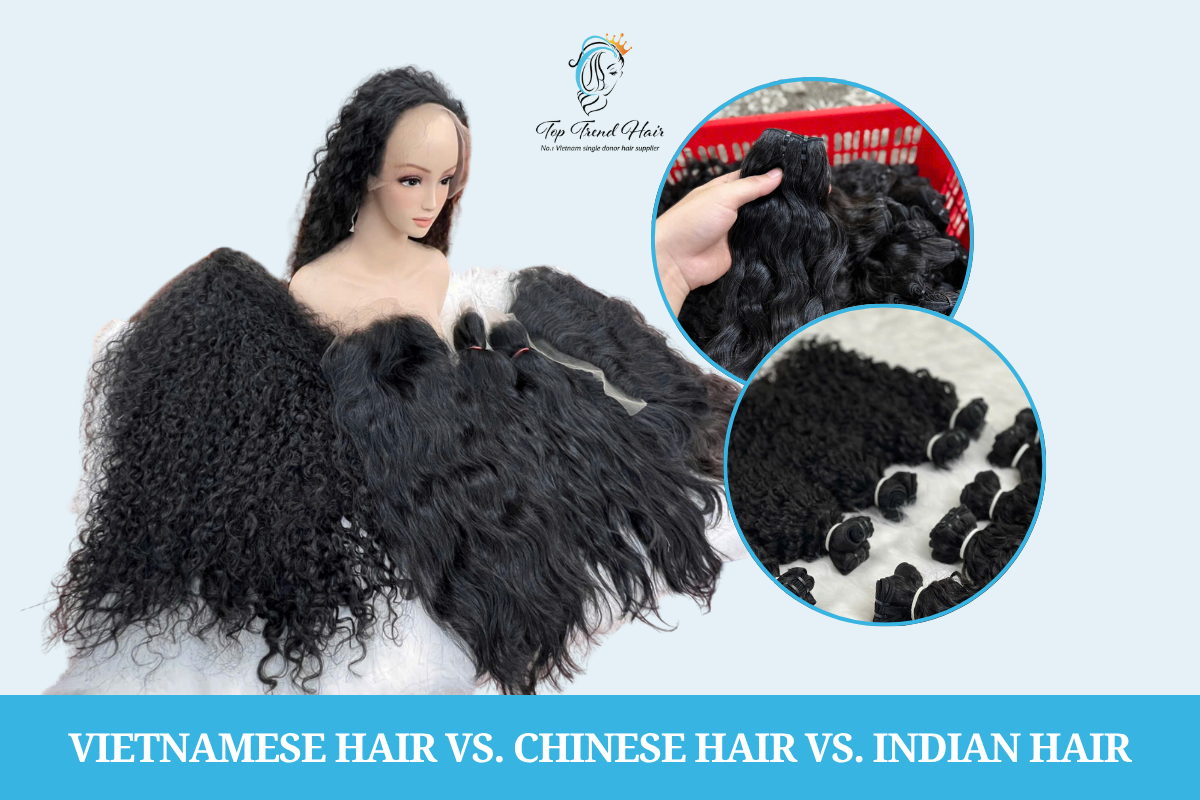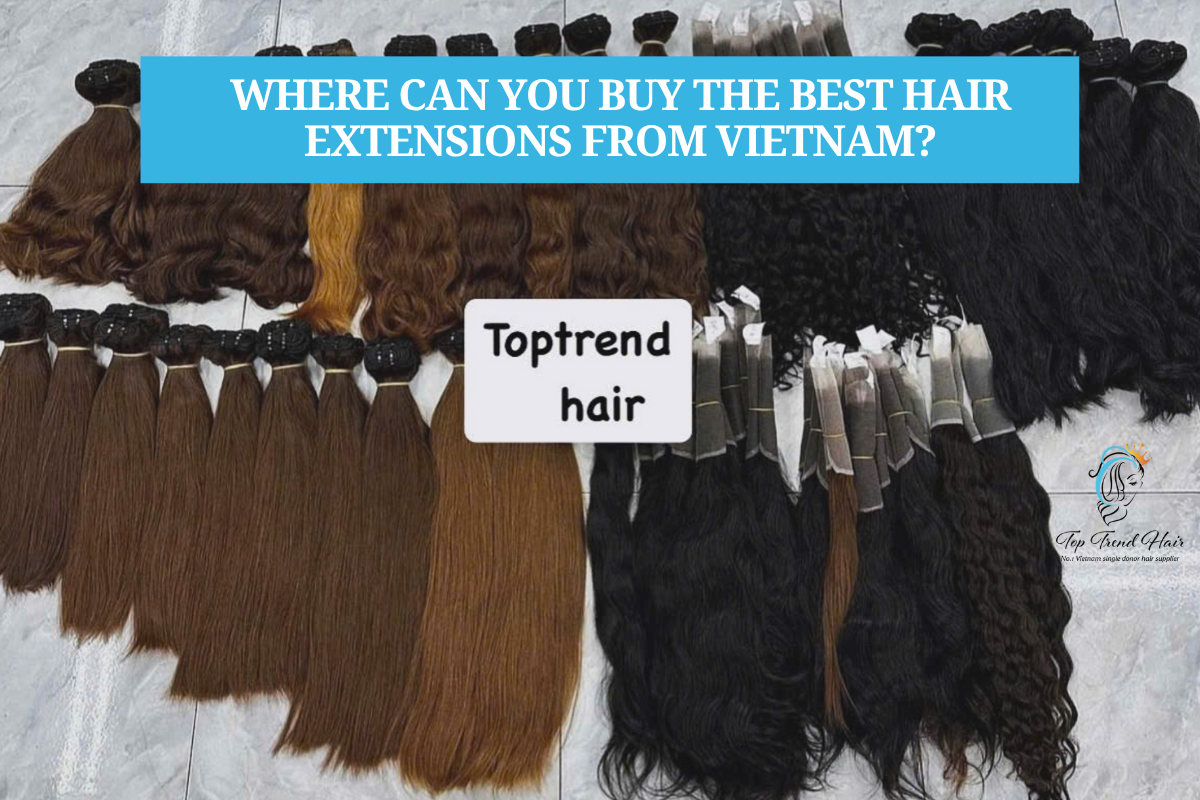If you’re in the hair business—whether you run a salon, manage a wholesale operation, or supply extensions to global markets—you already know that not all hair is created equal. Vietnamese, Chinese, and Indian hair are three of the most talked-about sources in Asia. Each comes with its own unique qualities, pros, and trade-offs. In this article, TopTren Hair will break them down clearly so you can choose the right type of hair that fits your brand, your customers, and your business goals.
Overview: Vietnamese Hair vs. Chinese Hair vs. Indian Hair
The global hair market is growing fast, with Vietnam, China, and India standing out as top suppliers. Among many hair-exporting countries, Vietnamese, Chinese, and Indian hair are the most popular choices for international buyers due to their unique qualities.
- Vietnamese Hair: Known for its strength, smoothness, and long-lasting quality. Most hair is collected from young women in rural areas who have healthy hair care habits. This makes Vietnamese hair strong, natural-looking, and easy to dye or style.
- Chinese Hair: Popular for its wide variety and large stock. Chinese suppliers often process hair heavily to meet high demand, so the hair is less natural but very affordable and available in many textures, colors, and styles.
- Indian Hair: Famous for being soft and lightweight. Most Indian hair is collected from temples (temple hair), where people donate it. It blends well with many hair types, especially curly or wavy styles. However, it is usually thinner than Vietnamese or Chinese hair.

The information of Vietnamese Hair, Chinese Hair and Indian Hair
Similarities Between Vietnamese Hair, Indian Hair, and Chinese Hair
While there are differences, Vietnamese hair, Indian hair, and Chinese hair share several similarities. Below are some of the most notable ones.
Natural Origins
All three hair types are sourced from humans. Whether it’s Vietnamese, Indian, or Chinese hair, the majority of these are human hair collected from real people, often with minimal to no chemical treatment initially.
Versatility in Styling
These three types of hair can be styled, dyed, and cut into different shapes and lengths. Whether you’re looking for a natural look or a dramatic transformation, all three hair types can be styled to meet various needs, from straightening to curling, and they hold color well after dyeing.
Raw and Virgin Hair Availability
Raw and virgin hair (unprocessed hair) is available in all three types, though the percentage may differ depending on the supplier. Raw hair is desirable because it retains its natural texture and strength, making it ideal for high-quality extensions and wigs.

They also have good hair qualities
Global Market
Vietnamese, Indian, and Chinese hair are all highly sought after in the global hair market. They have become some of the top choices for businesses involved in hair extensions, wigs, and beauty products due to their diverse offerings and availability.
Durability and Longevity
With proper care, all three hair types can last for several months to years. While the lifespan can vary slightly (with Vietnamese hair lasting longer on average), all three hair types are durable when maintained correctly.
Various Textures
All three types of hair come in a range of textures, such as straight, wavy, or curly. This allows businesses and consumers to choose based on their specific needs, whether they are looking for a sleek, straight look or voluminous curls.
Compatibility
Vietnamese, Indian, and Chinese hair can all blend well with various natural hair textures, particularly African American hair or Western hair types, making them versatile options for people with diverse hair needs.
Besides, all three types are crucial to the global beauty and hair extension industry, particularly in markets like the United States, Europe, and Africa, where they are used to create natural-looking wigs, weaves, and extensions.
Easy to be processed
These hair types can all be processed to suit different beauty demands. For example, they can be treated for silkiness, straightened, or curled to create a variety of hair products, from wigs to hairpieces.
Vietnamese Hair vs. Chinese Hair vs. Indian Hair: Key Differences
To clearly know the difference between these 3 hair types, you need to understand the information in the following table.
| Criteria | Vietnamese Hair | Chinese Hair | Indian Hair |
| Origin | Collected directly from rural women, consistent, high quality | Imported from various regions, processed in large factories | Temple hair (donated from temples), sometimes floor hair |
| Hair Quality | Soft, smooth, thick, and natural | Thinner, heavily processed, coated with silicone | Naturally wavy, medium to coarse texture |
| Lifespan | 3-4 years with proper care | 6 months to 1 year, depending on processing level | 1–1.5 years (temple hair), shorter for lower-quality hair |
| Styling Flexibility | Easy to dye, curl, straighten, bleach | Variety of textures and colors, suitable for mass production | Best for curly/wavy styles, can be straightened or dyed |
| Processing Level | Raw/virgin, minimal processing | Heavily processed, ready-to-use | Lightly processed, mostly natural textures |
| Price | Higher due to premium quality and ethical sourcing | Affordable, mass-produced | Mid-range, varies depending on quality (temple vs. floor hair) |
| Best Use Cases | Ideal for high-end extensions and wigs, long-term users | Ideal for fast fashion, budget extensions, mass markets | Best for curly or wavy styles, African or Western hair markets |
Where can you buy the best hair extensions from Vietnam?
If you’re looking for the highest-quality hair extensions from Vietnam, TopTrend Hair is one of the most reliable suppliers you can trust. Based in Vietnam with years of experience in the hair industry, TopTrend Hair specializes in raw Vietnamese hair, ethically sourced from women in rural and mountainous areas.

TopTrend Hair – Top reliable hair vendors in Vietnam
Our products are well-known for their soft texture, natural shine, and long-lasting durability, making them ideal for salons, wholesalers, and hair brands worldwide. Whether you’re in need of bulk orders, customized textures, or premium wigs, TopTrend Hair offers consistent quality, competitive pricing, and global shipping to meet every client’s needs.
Conclusion
There’s no one-size-fits-all answer when it comes to choosing between Vietnamese, Chinese, and Indian hair. It really depends on what your clients want and what matters most to your business—whether that’s natural texture, price, consistency, or ethical sourcing. Hopefully, this comparison has given you a clearer picture to move forward with confidence. Making the right choice isn’t just about the product—it’s about building trust, delivering quality, and growing a brand your customers can rely on.



